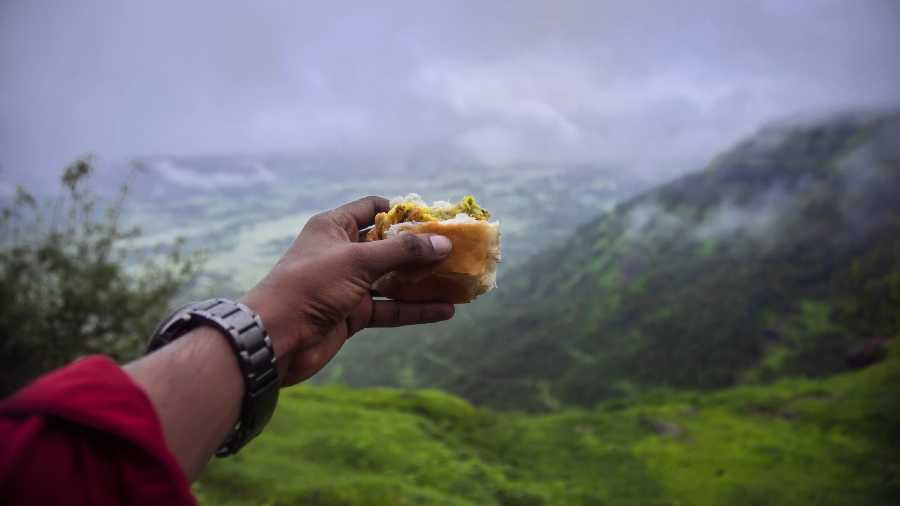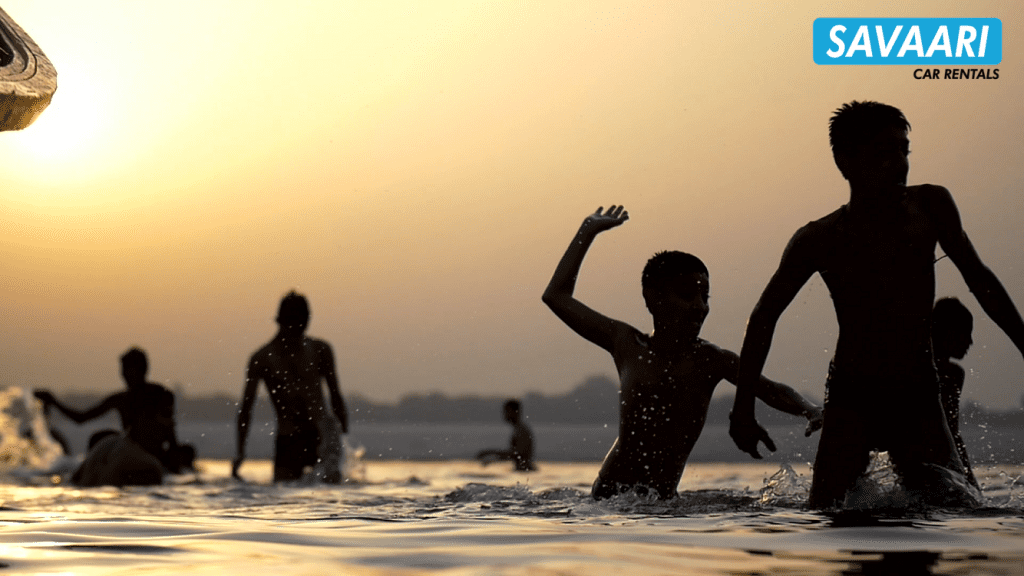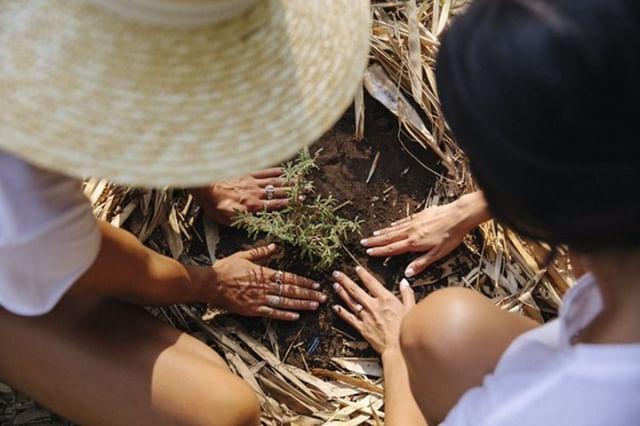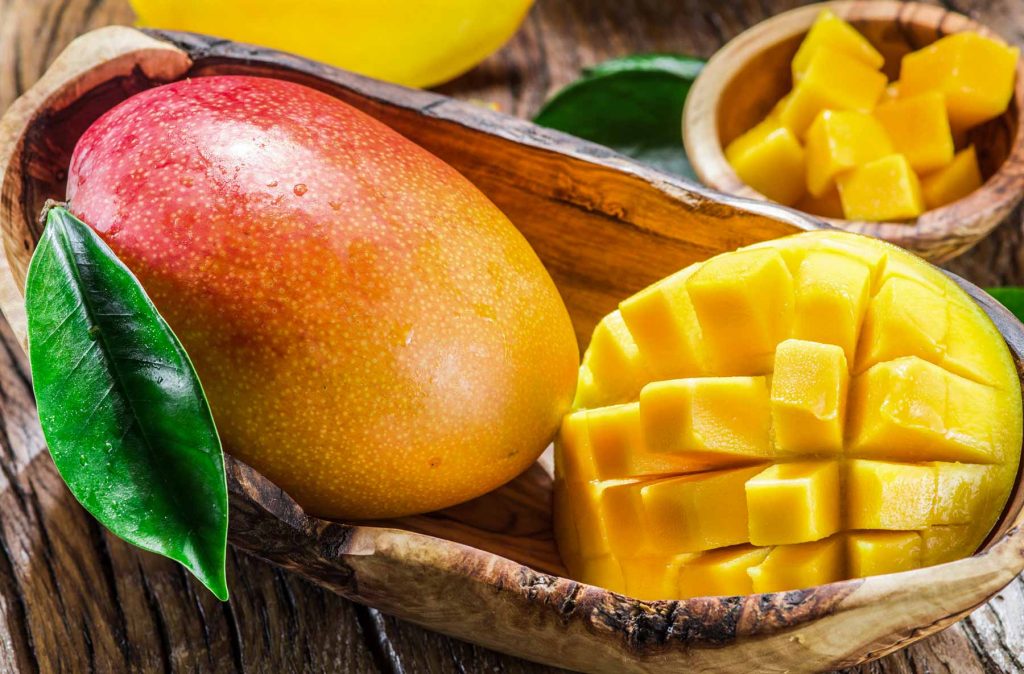The rains bring a mix of emotions; for some, it’s a touch of melancholy, while for others, it sparks unexpected joy. Whether you’re feeling the blues or a sudden burst of happiness as you watch the rain’s rhythmic dance, one thing is certain: food makes the experience even better. There’s something magical about enjoying the monsoon from the comfort of your window, sipping a hot cup of tea, listening to Kishore Kumar, and indulging in crunchy, steaming hot pakoras. Somehow, food just tastes better in the monsoon.
But pakoras, samosas, and chaats are just the beginning. Every region in India has its own unique monsoon delights that are sure to thrill your taste buds. While we often crave fried goodies during this season, each area also offers healthy and nourishing options. From savory snacks to flavorful beverages, the monsoon brings a culinary adventure that’s both comforting and exciting.
At Savaari, we’ve been road-tripping across India for over 17 years, guiding customers to various parts of the country. Our experienced chauffeurs, who have journeyed extensively, know the best local foods to satisfy those monsoon cravings. Whether it’s a road trip in a Savaari from Bangalore to Ooty—our most popular monsoon destination—or a journey from Chennai to Munnar, our drivers have been safely transporting passengers while indulging in local culinary delights. We decided to ask our chauffeurs about their favorite monsoon foods and the travel stories that made their customers fall in love with the local cuisine and the places they visited. Here’s what they shared.
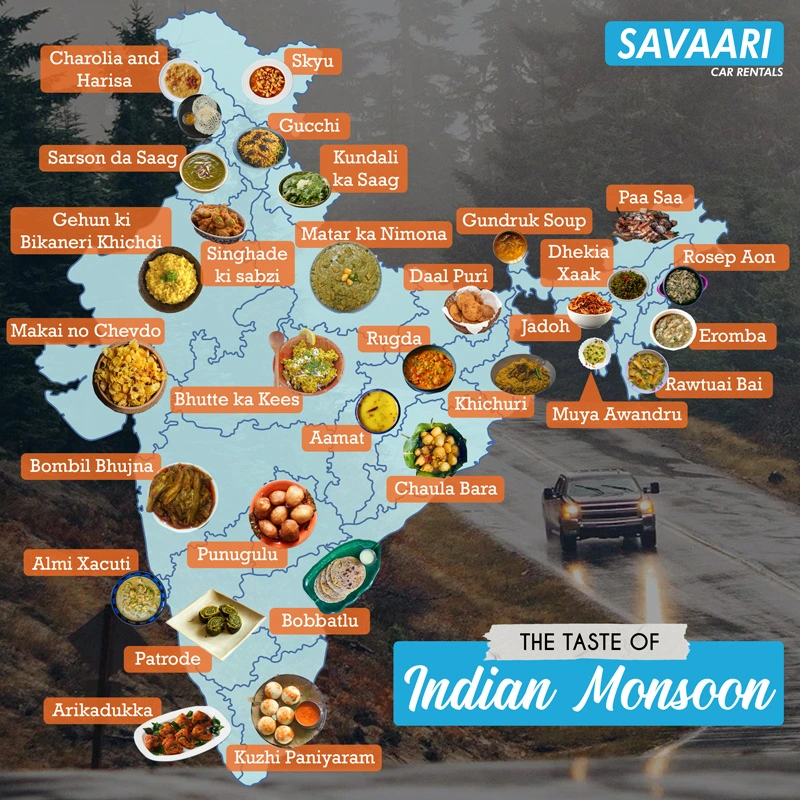
Bihar – Dal Puri and Bachka
Gulzarilal, a native of Manasapur Village in Bihar, has been driving for Savaari for the past 10 years. He loves many things about the monsoon, especially driving in the rain, listening to a great monsoon playlist while on the road, and discovering delicious monsoon treats along the way.
He fondly remembers the incredible monsoon foods he grew up with. Whenever he finds himself driving through stormy weather, his thoughts drift to getting home safely and enjoying his wife’s Chana Dal Puri with Bihari Aloo Bhujia. “We don’t usually make puris, especially for breakfast, but during the monsoon, it’s a special exception,” he shares. “Once, my customers wanted to try something unique and local in Bihar, so I took them to a local restaurant. They had chana-stuffed puris with aloo bhujia (potato fry) for breakfast, and it was gone in no time. It was simply delicious and irresistible.”
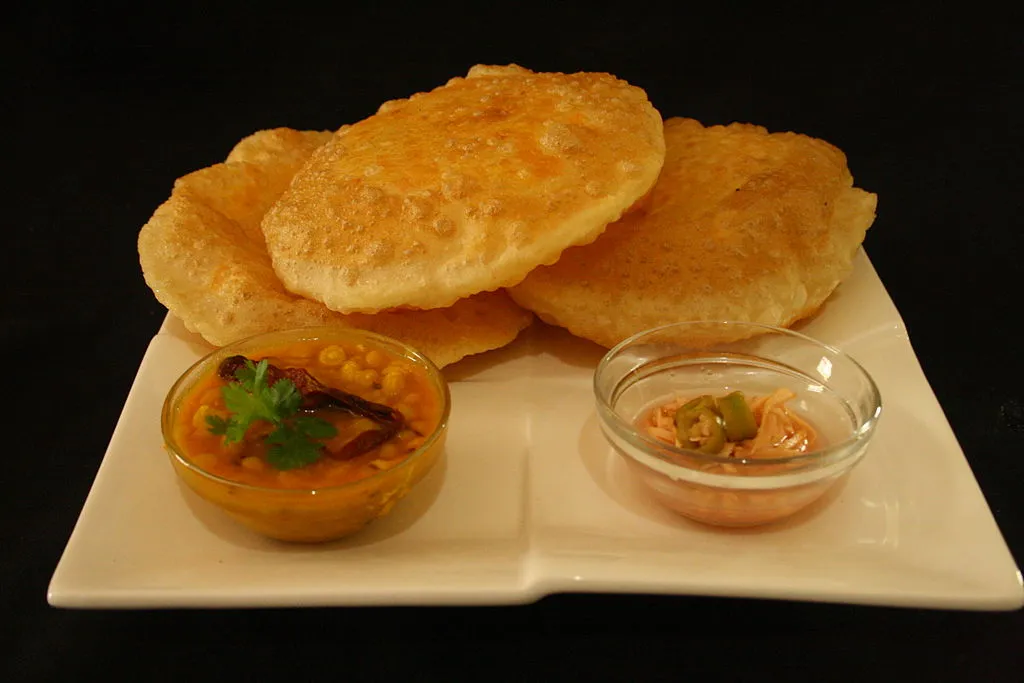
He also recommends another monsoon favorite: Bachka. “While sattu, made from kala chana, is a staple in Bihari cuisine, Bachka is a delightful delicacy similar to the pakoras enjoyed in North India during the winter and monsoon seasons. I remember having Bachka as a snack in my childhood. Though I try to avoid fried monsoon food now, Bachka is simply irresistible.” Traditionally made with potatoes or brinjal, this dish can also be prepared with onions, kala chana, gram flour, and a few spices. So, when in Bihar, make sure to try Chana Dal Puri and Bachka during the monsoon.
Goa – Almi Xacuti
Joseph has been navigating the scenic routes of Goa in a Savaari cab for over 12 years. A true Goankar at heart, Joseph has a deep love for his homeland and its unique culinary traditions. One monsoon food favourite that holds a special place in his heart is Almi Xacuti.
“Monsoon in Goa is magical,” Joseph begins with a smile. “The rain brings out the lush greenery and the forest mushrooms, known locally as ‘almi,’ which are perfect for making Mushroom Xacuti. This traditional Goan dish, with its rich and aromatic blend of spices, is a true gem of our cuisine.”
Joseph fondly remembers his childhood during the monsoons. “I remember my mother collecting wild mushrooms from the forest after a good rain. She would then prepare Almi Xacuti, and the whole house would be filled with the most incredible aroma, especially after celebrating the São João Festival, the tradition of jumping into a well. The earthy flavor of the wild mushrooms combined with the spicy, coconut-based Xacuti masala served along with buttered pav and matar pulao was simply divine.”
He continues, “Xacuti is a popular Goan masala used in many gravy-based recipes across India, but there’s something uniquely special about having it with fresh, seasonal mushrooms during the monsoon. It’s a taste of Goa that you can’t find anywhere else.” If you ever find yourself in Goa during the rainy season, take Joseph’s advice and indulge in the rich, flavorful delight of Almi Xacuti.
Meghalaya – Jadoh
Phiwstar is a seasoned Savaari driver who has been navigating the enchanting landscapes of Meghalaya for years. Meghalaya, known as the wettest place on Earth with an astounding 467 inches of rain per year, offers some of the most interesting monsoon foods. Known for his warm smile and deep knowledge of local traditions, Phiwstar often takes tourists to explore the hidden gems of the region. One of his favorite destinations is Mawlynnong Village, famously known as the cleanest village in Asia. But beyond its cleanliness, Phiwstar loves introducing visitors to the local cuisine, especially the traditional Jadoh of the Khasi tribe.
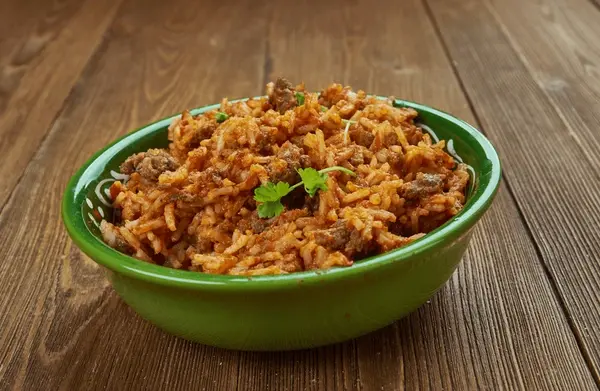
On one memorable trip, Phiwstar recalls a group of adventurous tourists eager to experience authentic Khasi food. He asked if they wanted the version suitable for tourists or if they were adventurous enough to try the traditional Jadoh of the Khasi tribe. In Khasi language, ‘Ja’ means rice and ‘Doh’ means meat. The locals also enjoy ‘Jadoh snam,’ which is cooked in blood. “Jadoh for a Khasi is like biryani for a North Indian,” Phiwstar explains. “The rice is cooked with meat, but the spices are very different, and it doesn’t use much oil.”
He adds, “Most recipes of Jadoh snam emphasize carefully choosing the type of blood, as it can enhance or destroy the taste.” For the less adventurous, Phiwstar often recommends the Jadoh cooked in pork fat, which offers a delightful introduction to Khasi cuisine without the intensity of blood. “Many of my passengers opt for the Jadoh cooked in pork fat only, without blood. It’s a delicious and rich dish that truly captures the essence of Khasi culinary traditions.”
Chhattisgarh – Aamat
Meet Omkar, a Savaari driver from Bilaspur, Chhattisgarh. One dish that stands out for him during the rainy season is Aamat, a beloved comfort monsoon food in Chhattisgarh. “You can’t go wrong with a warm bowl of comfort during the monsoon,” Omkar says. “And Chhattisgarh firmly believes in this.” The word ‘aamat’ literally means sour, and this dish is a tangy soup made with mixed vegetables, Gondi, and Kareel (bamboo shoots). It is a popular and important dish of Bastar, celebrated for its unique flavors and nourishing qualities.
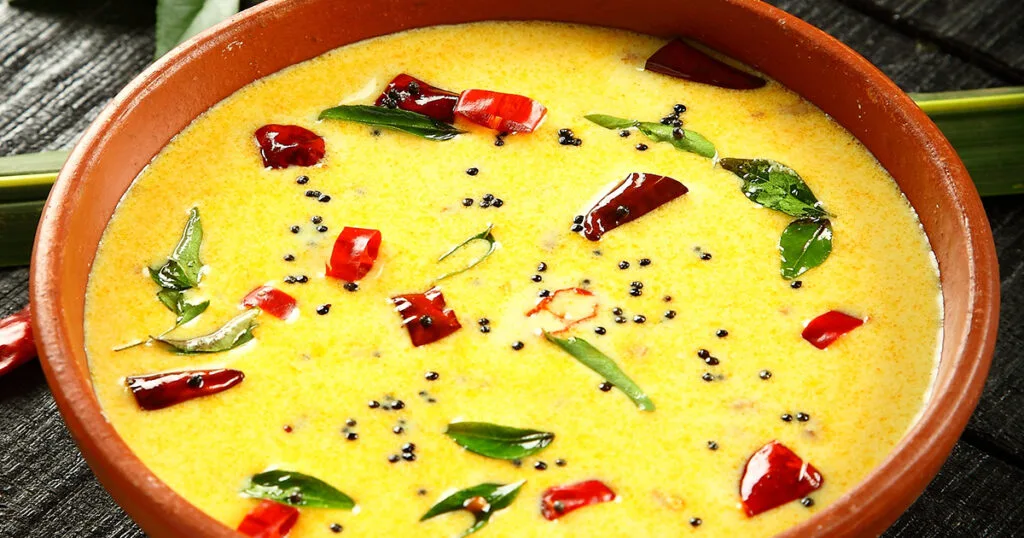
Omkar recalls how Aamat has been a staple in his family for generations. He shares a fond memory of his childhood, sitting in the kitchen while his grandmother prepared Aamat. “She would gather fresh vegetables and bamboo shoots, patiently cooking them to perfection. The whole house would fill with the rich, tangy aroma. I would eagerly wait for that final tadka, which added a spicy kick to the dish.”
For Omkar, Aamat is more than just food; it’s a symbol of home and tradition, especially cherished during the monsoon season. “The tanginess of the soup, combined with the warmth of the spices, makes it perfect for rainy days,” he says.
Maharashtra – Bombil Bhujna
With a wealth of experience and a deep love for his state, Shivaji Apte takes immense pride in sharing its culinary treasures. While the iconic Vada Pav is a staple in Mumbai that many relish, Shivaji’s favorite monsoon season food is something more unique: Bombil Bhujna, or Bombay Duck Curry.
Shivaji grew up near the coast where Bombay duck was a common catch during the monsoon. “This marinade of fish with coriander and green chilies is an ode to the monsoon weather around,” he says. “The fresh, tangy flavor of the curry perfectly complements the rainy season.”
For seafood lovers, Shivaji believes Bombil Bhujna is a must-try, especially during the rainy season. “It’s a dish you can’t miss out on,” he says enthusiastically. “There’s nothing quite like the combination of freshest Bombay duck, marinating it with a blend of spices, coriander, and green chillies cooked to perfection, absorbing all the rich flavours of the marinade.”
Shivaji often reminisces about family meals during the rainy season, with Bombil Bhujna taking center stage. “The aroma of the curry would fill our home, bringing everyone together at the dining table,” he recalls. “It’s more than just a dish; it’s a celebration of our coastal heritage and the monsoon’s bounty.”
Madhya Pradesh – Bhutte Ka Kees
Jamath, a Savaari driver from Indore, shares the special connection between monsoon and corn (Bhutta) in Bhopal. “This is the time when various recipes of corn – Bhutte ka Kees, Bhutte ki Kachori, Bhutte ki Tikki, Bhutte ki Pulao with Masala, Bhutte ka Soup, and Bhutte ke Pakode – sell in the city,” he says. Among these, the most popular is Bhutte ka Kees, made from grated corn kernels cooked with spices, milk, and ghee. “It’s often garnished with grated coconut, coriander leaves, and lemon juice to zinger up your tang,” Jamath adds.

Jamath fondly recalls taking his customers to Sarafa Bazaar in Indore to try these delicious street monsoon food treats. “All my customers love it, and they are always so satisfied,” he says. The rich flavors and unique textures of these corn-based dishes make them a must-try during the monsoon season in Madhya Pradesh.
Arunachal Pradesh – Paa Saa
Meet Wangsu, a Savaari driver who has been exploring the scenic landscapes of Arunachal Pradesh for years. One dish he especially misses during his long drives is Paa Saa, a traditional fish soup that holds a special place in his heart.
“The preparation of Paa Saa is tedious, but the outcome is enjoyed and relished by many,” Wangsu says. “It’s more than just a monsoon food; it’s a communal activity where everyone comes together. We catch the fish and mince it meticulously, ensuring that every part is utilized and nothing goes to waste.”
For Wangsu, the magic of Paa Saa lies in its unique taste and vibrant green color, lent by the uriam leaf. “The leaf not only gives the dish its distinct color but also neutralizes the taste of the raw fish,” he explains. “Along with the fish and uriam leaf, the dish includes chives, coriander, ginger, garlic, chili, and white basil. The blend of these ingredients creates a flavor that’s simply unforgettable.”
Jammu and Kashmir – Charolia and Harisa
Javed from Srinagar recommends two delightful monsoon dishes from Jammu and Kashmir: Charolia and Harisa. His customers frequently book Savaari cabs from Srinagar, and he always suggests these dishes to them, which they love.
Charolia
Charolia is a nutritious and comforting monsoon food made from buckwheat flour, ideal for the monsoon season. These steamed dumplings are flavoured with a unique blend of local spices and herbs, making them both light and filling. Traditionally enjoyed during the rainy season, Charolia pairs wonderfully with a bowl of hot soup or curry, providing a wholesome and satisfying meal.
“It’s not just healthy but also incredibly tasty,” Javed adds. “Whenever I drive through Srinagar during the monsoon, I always make it a point to stop and enjoy a serving of Charolia. It’s a dish that warms the body and soul.”
Harisa
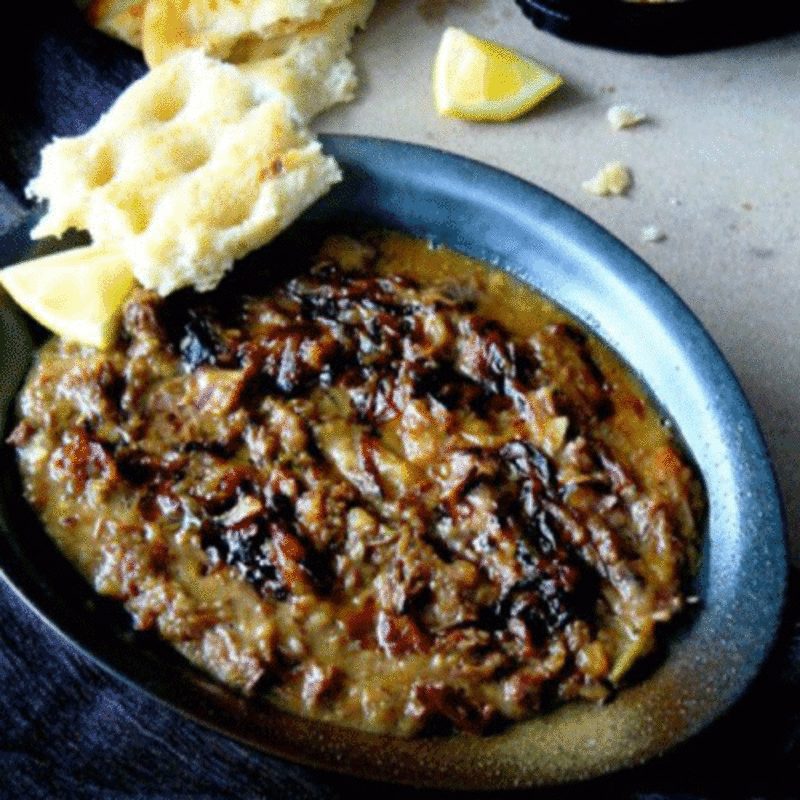
Harisa is another popular traditional dish in Kashmir, perfect for the monsoon season. It is made by slow-cooking mutton with rice, lentils, and a blend of spices until it reaches a smooth and creamy consistency. This hearty dish is usually served hot with a dollop of ghee and is best enjoyed with hot naan or crusty bread. “Harisa is the ultimate comfort food,” says Javed. “The rich, creamy texture and the warmth of the spices make it perfect for cold, rainy days.”
Tamil Nadu – Kuzhi Paniyaram, Adhirasam, and Vazhakkai Bajji
Srinivas loves to share the culinary delights of Tamil Nadu with his passengers. One of his favorite monsoon food is Kuzhi Paniyaram, a type of savory or sweet pancake. “In Tamil Nadu, Kuzhi Paniyaram is a beloved treat during the monsoon season,” Srinivas says. These small, round pancakes are cooked in a special iron pan, giving them a unique texture and appearance. Whether enjoyed plain or with a variety of toppings, Kuzhi Paniyaram is a delightful treat that perfectly complements the rainy weather.
Srinivas also recommends trying Adhirasam, a traditional sweet snack made from rice flour and jaggery. The dough is fermented, rolled into discs, and fried until golden. “Adhirasam has a rich, caramel-like flavor from the jaggery and a satisfying crunch,” Srinivas explains. “It’s a perfect companion for a cup of filter coffee on a rainy day.”
Another monsoon favorite in Tamil Nadu is Vazhakkai Bajji, fritters made from raw banana or plantains. “These fritters are crispy on the outside and soft on the inside,” says Srinivas. “They’re often enjoyed with a side of coconut chutney or a tangy tamarind sauce. The combination of flavors is simply irresistible.”
So, if you find yourself in Tamil Nadu during the monsoon season, take Srinivas’s advice, book a local Savaari in Chennai, and indulge in these delicious treats.
Odisha – Chaula Bara
Rakesh has been driving for Savaari for 5 years, often taking customers to Odisha’s famous Rath Yatra. Along the way, he loves sharing the flavors of Odisha with his passengers. One of his favorite snacks is Chaula Bara, a popular street monsoon food in Western Odisha. “Chaula Bara is crunchy on the outside and fluffy on the inside,” Rakesh explains. “It pairs perfectly with two special chutneys: tentel jhol (tamarind water) and patalganta chutney (tomato chutney).”
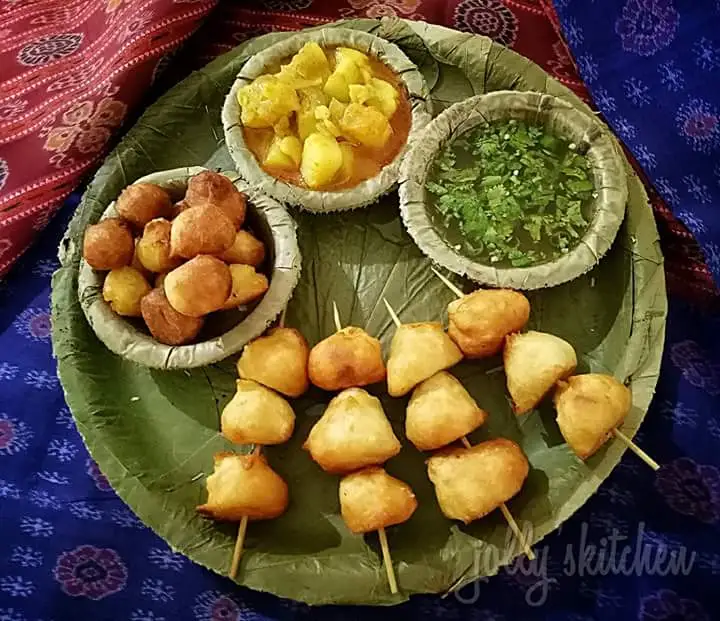
Rakesh fondly describes the experience of enjoying this snack during the monsoon. “When the hot baras are dipped into the tangy tamarind water and the flavorful tomato chutney, it tastes heavenly, especially while watching the rain,” he says. “It’s a simple yet delightful treat that captures the essence of Odisha’s street food culture.”
Mizoram – Rawtuai Bai
John, a Savaari driver in Mizoram, often introduces his customers to the local monsoon delicacy, Mautuai Bai. Bamboo shoot, or Mautuai, is a versatile ingredient in Mizoram cuisine, prepared in various styles such as boiled, fried, or pickled. Mautuai Bai, a mixture of bamboo shoot with vegetables and sometimes meat, is a staple dish. “In Mizo culture, every meal includes a dish called bai,” John explains. “Rawtuai Bai, a bamboo shoot stew, is one of the tastiest and simplest side dishes, often combined with other vegetables for added flavor.”
One memorable experience involved Cecilia, a traveler exploring Aizawl. “I was in a Savaari cab with John, who suggested trying Mautuai Bai,” Cecilia shares. “I had never tasted bamboo shoot before, and his recommendation turned out to be a highlight of my trip. John’s local knowledge and Savaari’s excellent service made my journey through Mizoram truly unforgettable.”
Uttarakhand – Kandali ka saag
Kishen, a Savaari driver from Uttarakhand, recommends trying the Pahadi dish Kandali ka Saag, made from the young leaves of the stinging nettle plant. These leaves are carefully cooked with garlic, onions, and spices to create a rich and flavorful saag.
Known for its high nutritional value, Kandali ka Saag is rich in iron, calcium, and vitamins, making it a healthy addition to the monsoon food. “It’s a unique dish that captures the essence of our local cuisine,” says Kishen. “The combination of nutritious nettle leaves with aromatic spices makes it both delicious and beneficial for health, especially during the rainy season.”
Kerala – Arikadukka
Thomas, a Savaari driver from Kerala, recommends trying Arikadukka, a beloved tea-time snack and specialty of North Kerala. This unique dish is made using mussels packed with a lightly flavored rice mixture. The mussels are steamed in their shells, allowing the rice to absorb their rich flavor, and then fried to perfection.
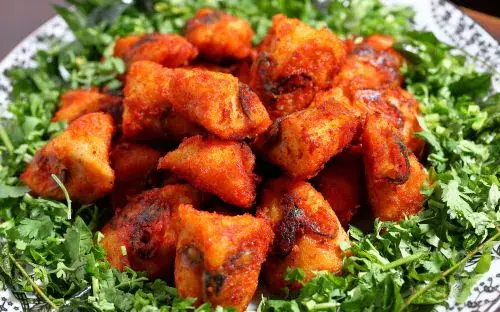
“With just a small amount of marinating, the rice takes on the taste of the mussels during steaming, and the flavor is further enhanced by frying,” Thomas explains. “It’s a delightful monsoon food, often enjoyed while strolling along a beach and sipping Sulaimani tea, a unique tea variety found in Kerala, capturing the essence of Kerala’s coastal cuisine.”
Karnataka – Patrode
Nishant, a Savaari driver from the coastal region of Mangalore, loves sharing his favorite monsoon food recommendations with passengers. “Come monsoon, almost every home in the coastal and Malnad regions of Karnataka gets busy preparing Patrode,” he says. “Patrode, or Patrado, is a much-loved dish made from colocasia leaves coated with a spicy rice and lentil batter, then steamed and sometimes lightly fried. It’s a recipe that traces its origin to Tulunadu and is derived from the Sanskrit words ‘Patre’ (leaf) and ‘Vade/Vado’ (dumpling).”
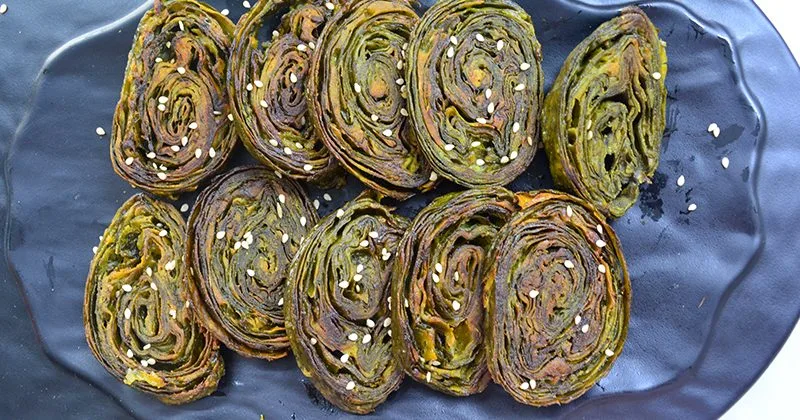
As he talks about monsoon food, Nishant lights up with nostalgia. “Another favorite is Goli Bajje, also known as Mangalorean Bajje. These fluffy, golden fritters made from all-purpose flour, yogurt, and spices like ginger and green chilies are fried to perfection and served hot with coconut chutney.”
He continues, “Mysore Bonda is another monsoon food. These deep-fried dumplings, made from urad dal batter with ginger, green chilies, and curry leaves, are fluffy and bursting with flavors. And then there’s Kodubale, ring-shaped treats made with rice flour, roasted chana dal, and spices like red chili powder, asafoetida, and cumin, deep-fried to a perfect crunch.”
Nishant recalls, “I grew up savouring these snacks every monsoon, and they bring so much comfort and joy. If you’re ever in Karnataka during the rainy season, you must try Patrode and these other delicious snacks. And if you are in Bangalore, you can always go on a dosa trail because dosas taste crispier and somehow more delicious in the monsoon!”
Manipur – Eromba
Achanba, a Savaari driver from Manipur, enthusiastically recommends Eromba, a traditional monsoon food from the Meitei community. “Eromba, pronounced ee-rom-ba, is a flavorful preparation made with dried and fermented fish and locally available veggies,” he explains. The prime ingredient is fermented dried fish known as Ngari in Manipuri (Nga means fish). These small freshwater fish, no longer than 10 cm, are sun-dried and then fermented in specially designed earthen pots called koloh or ngari chaphu, repeatedly smeared with oil but without any added salt.
“Eromba is usually prepared without oil, making it a healthy and simple yet flavorful meal accompaniment,” Achanba adds. “But if you prefer, you can use a little oil.” Since rice is the staple for the population in Manipur, Eromba pairs perfectly with a rice meal. “It also feels equally great with piping hot phulka or roti and a piece of raw onion,” he says.
Assam – Dhekia xaak bhaji
Thejas, a Savaari driver from Assam, recommends trying Dhekia Xaak Bhaji during the monsoon. He mentions that many people embark on Assam tea garden road trips during this season, and when they get hungry, he often suggests this dish.
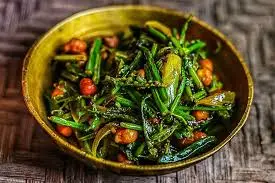
“Dhekia xaak are the edible ferns found in Assam,” he explains. This vegetable fern, known as linguda in northern India, is a staple in Assamese cuisine. The tender parts of Dhekia xaak are stir-fried with potatoes and chickpeas, creating a simple yet flavorful dish.
“Dhekia Xaak Bhaji is versatile,” Thejas continues. “Sometimes, it’s stir-fried with fermented bamboo shoots, tomatoes, or raw mango, adding unique flavors to the dish.” Typically served as a side dish with steamed rice, Dhekia Xaak Bhaji is a perfect accompaniment to a monsoon meal in Assam.
Tripura – Muya Awandru
Chandan from Tripura shares an intriguing monsoon food from his region: a rice flour-based gravy that, in some versions, contains snails. “Tripura decided to take things up a notch with this unique dish,” Chandan explains. While the inclusion of snails is optional, the gravy primarily features bamboo shoots, fermented fish, and chili peppers. Once prepared, the dish is garnished with parsley leaves.
“Tripuris are big believers in using fermented fish, also known as berma, in their dishes,” Chandan adds. “It’s extremely healthy since no oil is used during cooking.” He highlights that the aroma of the dish is particularly invigorating and is considered the most special element of the meal.
Nagaland – Rosep Aon
Keleto, a Savaari driver from Dimapur, Nagaland, shares Rosep Aon, a traditional monsoon signature dish of the Ao Naga Tribe. “Rosep Aon is a dish made of mixed vegetables, dry fish, and bamboo shoots,” he explains. “Rosep means dry and Aon means dish. It’s a dry side dish packed with the goodness of vegetables and flavors from fermented bamboo shoots and dry fish.”
Nagaland, a largely mountainous region rich in flora and fauna, is home to many tribes and sub-tribes, each with its unique cuisine. While some culinary traditions overlap, many delicacies are specific to particular tribes. He describes Rosep Aon as a completely ethnic dish, rich in nutrients and full of divine flavors. “This dish embodies the essence of Ao Naga cuisine, blending the distinct flavors of dry fish and fermented bamboo shoots with a variety of vegetables,” Keleto says. “It’s a must-try for anyone looking to experience the authentic tastes of Nagaland, especially during the monsoon season.
Punjab – Sarson da Saag and Puda
Jaspreet, a Savaari driver from Ludhiana, shares his love for Sarson da Saag, the quintessential Punjabi monsoon food. This classic dish is a favorite during the winter and monsoon seasons, made with mustard greens (Sarson da Saag) and maize flour bread (Makki di Roti). “It’s a hearty and wholesome meal, perfect for the cooler weather,” Jaspreet says. The combination of the rich, flavorful saag and the rustic, crispy roti makes it a beloved comfort monsoon food in Punjab.
Jaspreet also mentions Puda, also known as poore, a simple yet delightful sweet pancake prepared during the monsoon to welcome the rain. “Puda is made from a batter of flour, jaggery, and a hint of fennel seeds, then deep-fried until crispy,” he explains. This sweet treat is a favorite among Punjabis, adding a touch of warmth and sweetness to rainy days.
Himachal Pradesh – Gucchi
Ankush, a Savaari driver from Himachal Pradesh, shares his love for Lingdu ki Sabji, a pahadi special. “This nutritious dish is made from locally foraged fiddlehead ferns,” Ankush explains. The ferns are sautéed with spices such as cumin, turmeric, and red chili powder, often cooked with tomatoes and onions to enhance the flavor. “Lingdu ki Sabji is packed with vitamins and antioxidants, making it a healthy addition to any meal,” he adds.
Ankush also highlights the extraordinary Gucchi, known as the sponge mushroom. “Gucchi is rare and expensive, attracting the interest of foodies across the world,” he says. Found in the forests of Himachal Pradesh, Gucchi is highly prized for its unique taste and nutritional value. “Gucchi ka Madra and Chamba Dham with Gucchi Pulao are famous during the monsoon,” Ankush notes. These dishes showcase the rich culinary heritage of the region, combining local ingredients with traditional cooking methods.
Rajasthan – Gehun ki Bikaneri Khichdi
Afzal, a Savaari driver from Bikaner, Rajasthan, shares his favorite comfort food during the monsoon: Bikaneri Gehun ki Khichdi. “Growing up in Bikaner, rice wasn’t commonly used in our meals,” Afzal explains. “Instead, we used wheat, bajra, jowar, and other grains, which are considered beneficial for people dealing with diabetes.”
Bikaneri Gehun Dal Khichdi is made with wheat kernels instead of rice grains, combined with moong dal, and cooked in a pressure cooker. “The wheat kernels impart a great taste and crunch to the khichdi,” Afzal says. The dish is garnished with a tempering of light spice mixture, enhancing its flavor.
Afzal fondly recalls other monsoon food favorites from Bikaner. He has taken many customers to the Karni Mata temple, also known as the temple of rats, and he always suggests trying these snacks during the monsoon. It brings him joy when they enjoy the recommendations. “Pyaz ki Kachori, Rajasthani Mirchi Vada, and Gevar are perfect treats during the rainy season,” he adds. These dishes, with their rich flavors and unique textures, bring comfort and warmth during the monsoon.
Uttar Pradesh – Matar ka Nimona
Rajesh, a Savaari driver from Uttar Pradesh, loves sharing the flavors of his home state with passengers. One of his favorite monsoon food is Matar ka Nimona, a delightful UP-style Indian curry made with fresh green peas, potatoes, and minimal spices. “This tasty, soupy curry is perfect to pair with rice, chapati, or paratha,” Rajesh explains.
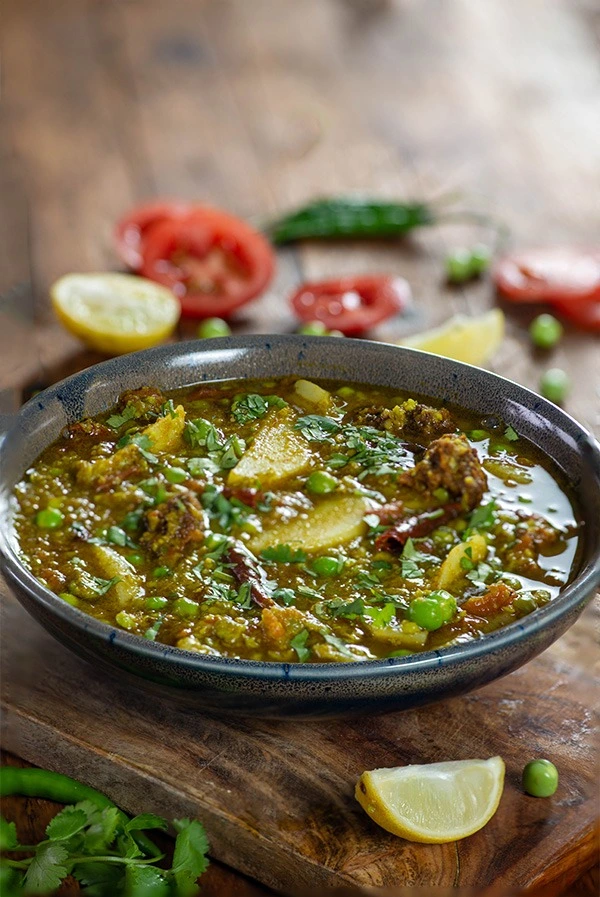
Matar ka Nimona is best made with tender peas that are at their sweetest, making it a seasonal treat during the monsoon. “The fresh peas give the curry a vibrant flavor and a natural sweetness that makes it so special,” Rajesh adds. The combination of peas and potatoes in a light, flavorful broth creates a comforting dish that’s perfect for the rainy season. To experience the best Matar ka Nimona, head to Lucknow. Booking a cab in Lucknow is your way to savoring this delicious monsoon food.
Jharkhand – Rugda Mushroom Curry
Nayan, a Savaari driver from Ranchi, recommends trying Rugda, a unique mushroom indigenous to Jharkhand. “Rugda grows naturally under the soil at the base of Sal trees in the humid forests of Jharkhand,” he explains. The mushrooms are white balls with a tough, rubber-like exterior, containing a yolk-like black substance inside that gives Rugda its distinctive taste.
Locals prepare a curry with Rugda, savoring its meat-like flavor, which is very similar to chicken liver, combined with a crunchy prawn-like shell. “Rugda is especially popular during the early monsoon season when many locals observe vegetarianism, serving as a great alternative to meat,” Nayan adds.
If you happen to visit Ranchi, Khunti, or Lohardaga districts during the rainy season, Nayan suggests asking a local vegetable seller about Rugda. “They might treat you to an authentic tribal dish made with Rugda,” he says. For those looking to try it at a restaurant, Nayan recommends booking a Savaari in Ranchi and heading to Yellow Sapphire at Capitol Hill and Jungli Moondance, though it’s best to check with the restaurant beforehand to ensure it’s available.
Haryana – Singhade ki Sabzi
Sanjay, a Savaari driver from Haryana, emphasizes the importance of nutritious monsoon food during the rainy season. “During the monsoon, there’s a refreshing breath of air, but also a higher chance of catching a cold,” he says. “Therefore, food preparations are crucial to provide nutrition and give the body an extra boost to fight infections.”
One such preparation is Singhade ki Sabzi, made with water chestnuts. “This dish is prepared with mustard seeds, cumin, turmeric, aamchur (dried mango powder), and besan,” Sanjay explains. “It’s a healthy dish that helps the body to prepare its defenses against harsh weather.”
Sanjay highlights the benefits of Singhade ki Sabzi, noting its nutritional value and its role in boosting the immune system. “The combination of water chestnuts and spices not only makes it flavorful but also helps in strengthening the body’s defenses,” he adds.
Telangana – Punugulu
Brijesh from Telangana, shares his love for Punugulu, a beloved monsoon snack. These crispy and savory fritters, made from fermented rice and lentil batter, capture the hearts and taste buds of people in Telangana. “It’s a common sight to find at least one shack in almost every lane of the city selling this snack,” Sanjay explains. The combination of the crunchy exterior and the soft, flavorful interior of Punugulu, paired with hot ginger chai, creates a comforting and satisfying snack that perfectly complements the rainy weather.
In addition to Punugulu, Sanjay recommends other popular monsoon snacks that you can enjoy by booking a local Savaari in Hyderabad. These include Mukka Jonna Chat, also known as Corn Chat, where freshly boiled corn kernels are tossed with vibrant spices, chopped onions, tomatoes, and tangy tamarind chutney; Kodi Korralu Bhaji, or Chicken Wings Bhaji, which are coated in a spicy batter and deep-fried; and Phulaurah, also known as Phulori, delightful and crispy snacks made from ground lentils and aromatic spices.
Andhra Pradesh – Bobbatlu and Garelu
Hriday, a Savaari driver from Andhra Pradesh, recommends two delightful monsoon treats: Bobbatlu and Garelu. Bobbatlu, also known as Puran Poli, is a sweet flatbread filled with a mixture of chana dal and jaggery. This delicious treat offers a perfect balance of sweetness and warmth, making it a must-have during the monsoon season in Andhra Pradesh.
On the savory side, Garelu, or Medu Vada, are lentil doughnuts that are crispy on the outside and soft on the inside. Commonly served with sambar and chutney, these savory delights are ideal for enjoying during the rainy weather. Both dishes highlight the rich culinary traditions of Andhra Pradesh and are perfect for adding a touch of comfort and flavor to monsoon days.
Gujarat – Makai No Chevdo
Driver Jignesh spends a lot of time in Ahmedabad, driving customers around and introducing them to the vibrant street food scene. One of his favorite recommendations, which his passengers often love, is Makai No Chevdo. Corn is a monsoon staple in India, and Gujarati cuisine incorporates it into this delicious snack. Made from desi corn (makai) or sweet corn, Makai No Chevdo is a unique Gujarati treat.
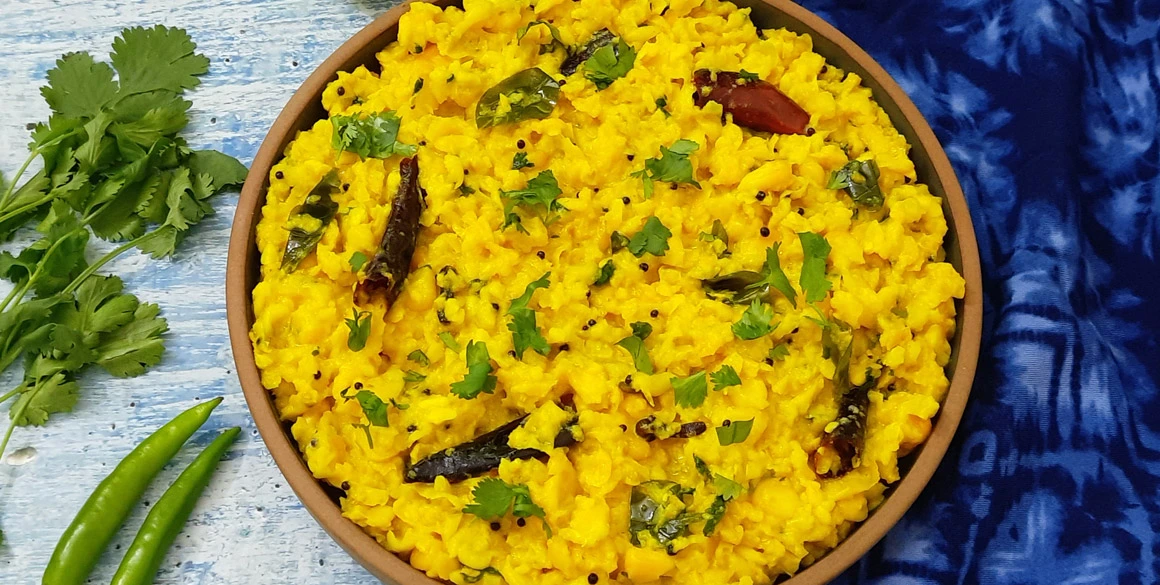
In some parts of Gujarat, it is known as Makai Khichdi. Despite its name, don’t confuse it with the dry kind of chivda made during Diwali, like cornflakes chivda, cereal chivda, or poha chivda. This version is wet, made from fresh or frozen corn. The taste of Makai No Chevdo is medium spicy with a perfectly balanced sweet and tangy flavor. The spiciness comes exclusively from green chilies, creating a delightful snack that embodies the essence of monsoon in Gujarat. If you find yourself in Ahmedabad during the rainy season, be sure to book a reliable local taxi and try this beloved dish and enjoy its unique and flavorful taste.
West Bengal – Khichuri, Aloo Chop, Mudi, Kabiraji Cutlets
Sayan, a Savaari driver from Kolkata, loves sharing the rich culinary traditions of West Bengal with his passengers. Among his favorite recommendations are the iconic Kabiraji cutlets, which hold an emotional significance for many Kolkatans. These crispy, flavorful delights connect generations and reflect Kolkata’s rich culinary tradition. The Kabiraji cutlet’s history is enchanting, originating in Bengal during the colonial era when British officials frequently requested cutlets similar to those they enjoyed in their homeland. Coated in batter and crumbs before being fried, these cutlets were initially referred to as “coverage cutlets,” which evolved into “Kabiraji” over time. Another story suggests that the dish was named after the renowned poet Rabindranath Tagore.
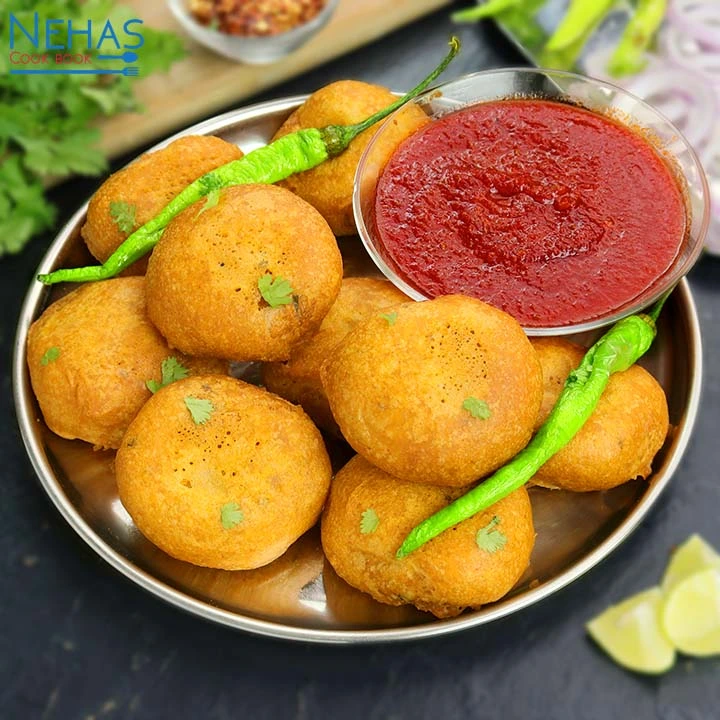
There are four types of Kabiraji cutlets: Mutton, Chicken, Fish, and Prawn, each offering a unique twist to its preparation. Kolkata’s street food scene is expansive and would require a whole day and an empty tummy to fully explore it. In addition to Kabiraji cutlets, Sayan recommends trying Aloo Chop, a fried item stuffed with mashed potatoes flavored with green peas, tomato slices, ginger paste, and various spices; Egg Rolls, a kind of spring roll filled with a delicious mixture of egg and spices wrapped in a flaky paratha; Khichuri, a comforting rice and lentil dish often enjoyed during the monsoon; and Mudi, puffed rice commonly paired with various savory snacks for a light and crunchy accompaniment.
Sikkim – Gundruk Soup
Sonam, a Savaari driver from Sikkim, suggests trying Gundruk, a traditional vegan dish perfect for the monsoon season. Gundruk is made by fermenting leafy vegetables such as cabbage, radish, or mustard leaves.
This dish, known for its unique tangy flavor, is often prepared in an earthen pot, which adds to its authentic taste and cultural significance. The fermentation process not only enhances the flavor but also increases the nutritional value, making Gundruk a healthy and satisfying choice during the rainy season. If you find yourself in Sikkim during the monsoon, be sure to try Gundruk and experience this traditional and wholesome dish.
Ladakh – Skyu
Tenzin, a Savaari driver from Ladakh, shares a traditional dish enjoyed during the rare rainy days in this high-altitude desert region. Despite Ladakh receiving only 13 rainfall days per year and a mere 106 mm (4.2 in) of accumulated precipitation, the locals have a delightful way to make the most of the much-anticipated rain.
Skyu is a traditional and hearty stew popular in Ladakh, comprising handmade pasta, veggies, and beef simmered in a flavorful broth. This dish is frequently served as a main meal and offers excellent comfort food for a chilly evening. Skyu’s handmade pasta is prepared from a simple blend of wheat flour, water, and salt, giving it a distinct texture and flavor that sets it apart from regular pasta. This dish is an all-time favorite, not just during the monsoon. Add Skyu to your foodie bucket list when you embark on a Leh Ladakh road trip, exploring Leh to Nubra Valley, Pangong Lake, and beyond.
To complement Skyu, Tenzin suggests pairing it with Butter Tea, also known as Gur Gur Chai, a traditional beverage in Ladakh. This unique tea is made with tea leaves, yak butter, and salt, creating a rich and warming drink.
Pro Tips for Eating in Monsoon
- During the monsoon, it’s hard to resist the innate craving for hot snacks for rainy season like pakoras, samosas, and bhajiyas. To ensure these treats are safe to eat, opt for eateries that are clean and hygienic.
- To stay healthy, incorporate healthy food to eat in rainy season such as soups, herbal teas, and steamed vegetables. These immune-boosting foods are not only nutritious but also help in keeping common monsoon illnesses at bay.
- Avoid street food that might have been exposed to rain, as it can be a breeding ground for bacteria. It’s safer to enjoy homemade or freshly prepared meals.
- Include plenty of fresh fruits and salads in your diet to maintain a balanced intake of vitamins and minerals. However, ensure that they are washed thoroughly with clean water.
- Drink boiled or purified water to avoid waterborne diseases. Staying hydrated is crucial, but it’s equally important to ensure the water is safe for consumption.
Following these tips will help you enjoy the monsoon season with delicious and healthy food choices!
Why book a Savaari to relish monsoon Indian food?
Monsoon Indian food is not only delicious but also healthy. From beloved classics like Punugulu and Kabiraji cutlets to lesser-known but equally delightful Rugda mushrooms, there are plenty of options to choose from.
However, during the rainy season, avoiding driving is crucial for safety. The best way to savor these monsoon foods without the hassle of commuting is by downloading Savaari’s car rental app and booking a cab. With Savaari, you won’t have to worry about stepping out each time to enjoy a delicious rainy season treat. Your expert chauffeur will take care of everything. Sit back, relax, and indulge in the taste of India’s most iconic monsoon food while your driver takes care of the rest.
Last Updated on August 19, 2024 by Shabari Shankar
